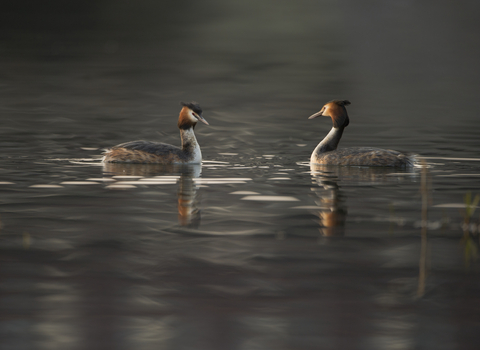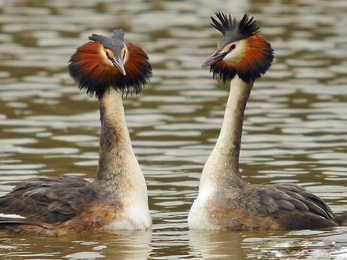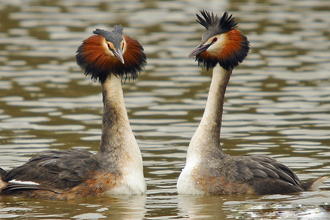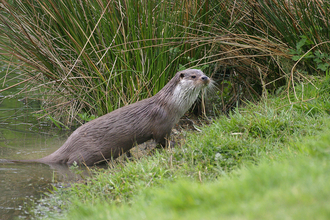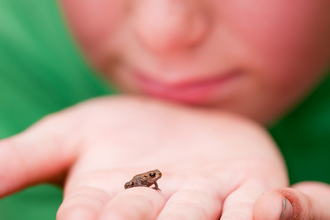Grebes
On early spring mornings, great crested grebe pairs join together to perform an elegant ritual. Head shaking, bill-dipping, and preening culminates in the famous ‘penguin dance’; the pair rush together, feet frantically paddling until they are upright, chest to chest, flicking beaks full of water weed at each other. A final head shake, the weed is dropped, and the deal is sealed. The plight of the great crested grebe was one of the triggers for the birth of the modern conservation movement. Laws and minds were changed, and 4,600 pairs of great crested grebes can be seen dancing on many park lakes, reservoirs, gravel pits, and canals.
These slinky water birds are famous for their wonderful courtship dance, a ritual fit for ‘Strictly’
Find grebes near you
Tring Reservoirs in Hertfordshire was where Julian Huxley first studied the behaviour and courtship display of the great crested grebe, then a great rarity, publishing his landmark paper in 1914 describing the dance for the first time. And the grebes are still here, presenting each other with their weed gifts and dancing their dance.
- Buckinghamshire, College Lake
- Cambridgeshire, Grafham Water
- Derbyshire, Hilton Gravel Pits
- Denbighshire, Gors Maen Llwyd (Llyn Brenig)
- Derbyshire, Willington Gravel Pits
- Essex, Abberton Reservoir
- Hampshire, Blashford Lakes
- Lincolnshire, Deeping Lakes
- Lancashire, Mere Sands Wood
- Lancashire, Wigan Flashes
- London, Woodberry Wetlands
- Nottinghamshire, Attenborough
- Perthshire, Loch of the Lowes
- Staffordshire, Croxall Lakes
- Warwickshire, Brandon Marsh
- Yorkshire, Staveley
How to do it
Great crested grebes are widely distributed across lowland Britain. Find a gravel pit, lake or canal with a pair in residence and try your luck. To make things more comfortable, settle in to a bird hide at a wetland nature reserve. All you need is a pair of binoculars and a little patience… although a thermos of hot tea might be appreciated too.
If you spot one, make sure to admire their head plumes (or ‘tippets’) that the great crested grebe was almost driven to extinction in Britain for (there were as few as 30 pairs left in the UK by the 1860s): The 19th century saw a fashion for bird plumes, used on hats and densely-feathered ‘grebe fur’ lined of fashionable capes and muffs. If you are lucky enough to see that final penguin dance, then come back in five weeks’ time and you should be able to see their humbug babies, riding on their parents’ back!
If you can't get there
From the comfort of your computer, you can also see some great footage of grebes going about their business at the BBC website. Your local park lake may not be home to great crested grebes, but look out for coot. Although not as extravagant as grebes, their courtship display involves pairs bowing in front of each other and nibbling the top of each other’s head, with wings raised and tail fluffed up. Coots are also very territorial, frequently chasing other birds off from their patch.
More wildlife experiences
From seeing colourful wildflowers to spotting magnificent birds of prey, we can help you get closer to wildlife across the UK.

